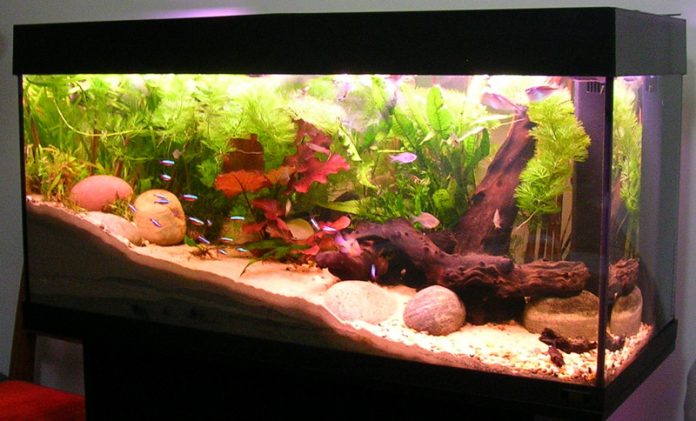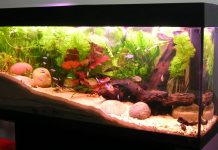Some aquarium owners put off cleaning their tank décor until algae had all but engulfed them. It’s not all that surprising with the busy schedules we all have that we may neglect the cleaning and maintenance required for a clean aquarium. Besides, your tank’s filter can only do so much.
However, cleaning your aquarium plants need not be a troublesome task. Read on for the safe and effective methods on how to clean aquarium plants. These tips and steps will also be perfect for when you’re performing your regular water change!
No to Soap!
If your first inclination is taking out your aquarium plants then washing them with soap and water, then might want to reconsider your plan. Soap and other cleaning products can be detrimental to your aquarium’s health.
Hence, never use detergent or dish soap, for any purpose in your aquarium’s life. Also, make sure your hands are completely free of soap when you take out your aquarium plants for cleaning.
Two at a Time
If you have an extensive collection of aquarium plants, then it would be best to clean at most two at a time. Limiting the number of plants you clean will minimize the stress that your fish will experience.
Cleaning Up!
There are several ways for you to safely and efficiently remove filth and algae build-up off of your aquarium plants. In cases where algae build-up is very light, you may just need to rub off the algae with your fingers. Alternatively, you could also gently shake them underwater to unsettle the algae.
However, for heavier build-ups and stubborn algae, take a look at the tools you need, and the steps below.
Artificial Plant Care
Artificial aquarium plants, whether they’re plastic or silk will be much easier to clean then live plants since you wouldn’t need to take the extra care cleaning them. However, strong chemical solutions and aggressive scrubbing can still damage the plants. Therefore, try first to use hot water to remove filth and algae. The how water kills the algae which will make it easier for you to remove them.
What you’ll need
- Soft Scrubber
- Hot water
- Heat-resistant containers
- Disposable Gloves
- Eye protection
- Bleach
- Uniodized salt
- Lemon Juice
- Old toothbrush
- Dechlorinator or water conditioner
Method 1: Boiling Water
- Wash your plastic plants under hot running water and try to rub off dirt and loose algae gently
- Boil some clean water then pour into a deep heat-resistant container
- Place your aquarium plants in hot water for at least 10 minutes
- With a gentle scrubber, scrub off the algae
- Let the artificial plants cool down completely
- Ensure hands are free of soap, dirt or chemicals, then place plants back into your aquarium
Method 2: Bleach Solution
You may need to resort to a bleach solution if there’s a markedly severe build-up of filth, waste, and algae on your aquarium plants. Here are the steps to removing the pesky build-up. Determine first if your aquarium décor is a plastic plant or a silk plant. You’ll find the cleaning methods for both types below.
Plastic plants
- Rinse plants under hot running water
- Put on your gloves and eye protection. Always wear protective gear when handling bleach.
- Make a 10% bleach solution. You can, for instance, mix one part bleach with nine parts hot water in a deep heat-resistant container.
- Place the plants in the solution and let them sit for about 10 minutes.
- Gently shake the plants under the solution if the gunk build-up dislodges or dissolves. If there is still a lot of gunk, let the plants sit for another 10 minutes. Repeat this process until the build-up washes away under hot running water. Remember that artificial plants, most especially brightly-colored ones, may lose their color you soak them in bleach for extended periods of time.
- Transfer the clean plastic plants into another container of hot water.
- Following the instructions on the label, add a water conditioner or Dechlorinator to remove the bleach completely. Let them sit in this solution for an hour.
- Once the plants have no trace or smell of bleach, wash them one final time under hot running water. If you’re unsure, though, let them air dry for one or two days for any remaining bleach to evaporate.
- Return the plants to your aquarium.
Silk plants
- Wash the silk plants under hot running water
- In a bowl, make a paste from half a cup of uniodized salt and lemon juice.
- Use a gentle scrubber or a soft old toothbrush with the paste to brush the algae, filth, and gunk off of the silk plants
- Once you remove all dirt build-up, rinse plants one last time under hot running water then gently return to your aquarium.
Live Plant Care
The best practice with live plants is to clean them as soon as you notice gunk or algae build-up. However, when you do need to clean live plants that algae has all but completely engulfed, then bleach may be necessary. You’ll need to act fast since algae overgrowth can be fatal for live plants.
Here are the steps:
- Gently remove the plants from your aquarium and wash under cool water
- Put on disposable gloves and eyewear
- Submerge in the 10% bleach solution for no longer than five minutes or less when you own fragile plant species.
- Transfer plants to a deep container with water and Dechlorinator. Let them sit for about 10 minutes.
- Rinse well under cool water then return to your tank, making sure to embed plant roots.
Conversely, if the plant dies during the fourth step, then the algae growth may have already done its deadly work on your live plant.
Conclusion
The health of your entire aquarium system depends heavily on your tank’s hygiene so remember to clean your tank on a regular basis thoroughly. If cleaning up thick gunk build-up is a hassle, then prevention is key. You may try routinely removing algae once you notice any growth.
Also, you might want to consider adding natural algae eaters to your tank to suppress algae build-up.
When you give your fish, coral, or live rock a clean home, they will reward you with many years of beauty and fulfillment!
>>> Read More:









